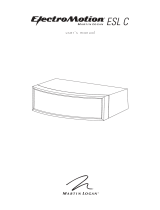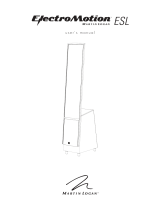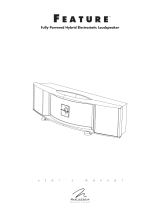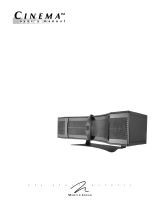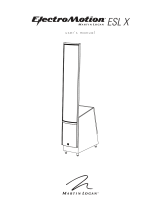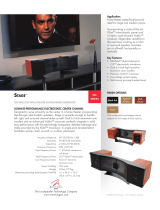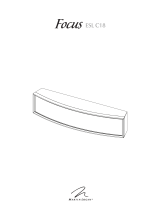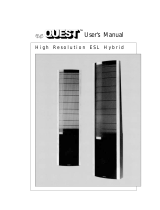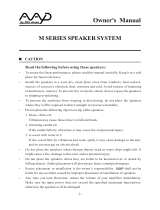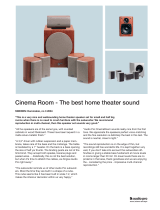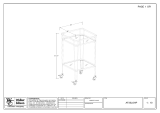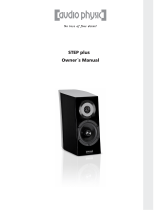Page is loading ...

user’s manual
tm

Serial Numbers: ________________ / ________________
Record your serial numbers here for easy reference. You will need this in-
formation when filling out your warranty registration. CLX’s serial number
is located near the bottom of the backplate and on the shipping container.
Each individual unit has a unique serial number.
This device complies with part 15 of
the FCC Rules. Operation is subject
to the following two conditions: (1)
This device may not cause harmful
interference, and (2) this device must
accept any interference received,
including interference that may
cause undesired operation.
CLX
Tested to Comply
with FCC Standards
FOR HOME OR OFFICE USE

Thank you—the MartinLogan owner,
for loving what we do,
and
making it possible for us to do what we love.

Contents ......................................4
Installation in Brief .............................5
Introduction ...................................6
Controls and Connections .......................7
AC Power Connection
Signal Connection
Break-In
ML Logo and CLX Light Switches
Setup and Placement ...........................8
Left/Right Placement
Listening Position
The Wall Behind the Listener
The Wall Behind the Speakers
The Side Walls
Experimentation
Final Placement ................................9
The Extra “Tweak” ............................10
Solid Footing
Enjoy Yourself
Room Acoustics ...............................11
Your Room
Terminology
General Rules
Dipolar Speakers and Your Room .................12
Dispersion Interactions.........................13
Controlled Horizontal Dispersion
Controlled Vertical Dispersion
Three Major Types of Dispersion
Home Theater.................................14
Electrostatic Advantages ........................15
Full Range Electrostatic Operation.................16
The lightning bolt flash with arrowhead symbol, within
an equilateral triangle, is intended to alert the user to
the presence of potentially “dangerous voltage” within
the product’s enclosure that may be sufficient to con-
stitute a risk of electric shock.
The exclamation point within an equilateral triangle is
intended to alert the user to the presence of important
operating and maintenance (servicing) instructions in
the literature accompanying the appliance.
MartinLogan Exclusives .........................17
XStat™ Transducer
CLS™ (Curvilinear Line Source)
Generation 2 Diaphragm
MicroPerf Stator
Vacuum Bonding
Uniform Full Surface Drive
Dipole Dispersion
DualForce™ ESL Bass Technology.................18
Dipole Phase Stabilization
Precision Vojtko™ Filtering
Electrostatic Loudspeaker History ................19
Frequently Asked Questions.....................21
Troubleshooting...............................23
General Information ...........................24
Specifications
Warranty and Registration
Serial Number
Service
Dimensional Drawings .........................25
Glossary of Audio Terms ........................26
In accordance with the European Union WEEE (Waste Electrical
and Electronic Equipment) directive effective August 13, 2005,
we would like to notify you that this product may contain regu-
lated materials which upon disposal, according to the WEEE
directive, require special reuse and recycling processing.
For this reason MartinLogan has arranged with our distributors
in European Union member nations to collect and recycle this
product at no cost to you. To find your local distributor please
contact the dealer from whom you purchased this product,
email [email protected], or visit the distributor locator at
www.martinlogan.com.
Please note, only this product itself falls under the WEEE
directive. When disposing of packaging and other related
shipping materials we encourage you to recycle these items
through the normal channels.
4 Contents
Contents
WARNING! Do not use your CLX loudspeakers outside of the country of original sale—voltage requirements vary
by country. Improper voltage can cause damage that will be potentially expensive to repair. The CLX is shipped to
authorized MartinLogan distributors with the correct power supply for use in the country of intended sale. A list of
authorized distributors can be accessed at www.martinlogan.com or by emailing [email protected].

Installation in Brief 5
We know you are eager to hear your CLX speakers,
so this section is provided to allow fast and easy set up.
Once they are operational, please take the time to read,
in depth, the rest of the information in this manual. It will
give you perspective on how to attain the greatest possible
performance from this most exacting transducer.
If you experience any difficulties in the setup or opera-
tion of your CLX speakers, please refer to the Room
Acoustics, Placement or Operation sections of this manual.
Should you encounter a persistent problem that cannot
be resolved, please contact your authorized MartinLogan
dealer. They will provide you with the appropriate technical
analysis to alleviate the situation.
WARNING!
• Hazardous voltages exist inside—do not
remove cover.
• Refer servicing to a qualified technician.
• To prevent fire or shock hazard, do not
expose this module to moisture.
• Turn amplifier off and unplug speaker if any
abnormal conditions occur.
• Turn amplifier off before making or breaking
any signal connections!
• Do not operate if there is any visual damage
to the electrostatic panel element.
• Do not drive speaker beyond its rated power.
• The power cord should not be installed,
removed, or left detached from the speaker
while the other end is connected to an AC
power source.
• No candles or other sources of open flame
should be placed on the speaker.
• No liquids either in glasses or vases should be
placed on speaker.
• Speaker should not be exposed to dripping or
splashing liquids.
• The terminals marked with the lightning bolt
symbol should be connected by an instructed
person or by way of ready made terminals.
• The power cord should remain readily acces-
sible and operable should any abnormal
conditions occur.
Step 1: Unpacking
Remove your new speakers from their packaging. Refer to
the unpacking diagrams printed on the CLX packaging
Step 2: Placement
Place each CLX so that the curvilinear electrostatic panel is
on the inside. Place each CLX so the electrostatic panels are
at least four feet from the back wall, two feet from the side
walls, and angled slightly toward your listening area. Please
see the Setup and Placement section (pages 8–10) of this
manual for more details.
Step 3: Power Connection (AC) (see warning)
Your CLX speakers require AC power to energize their
electrostatic cells. Using the AC power cords provided,
plug them in
first to the AC power receptacle on the rear
of the speaker
, making sure that you have made a firm
connection, and then to a wall outlet. Please see AC Power
Connection (pages 7) for more details.
Step 4: Signal Connection
Higher quality cables, available from your audio video
dealer, are recommended and will give you superior per-
formance. Use the best speaker cables you can. Spade
connectors are suggested for optimum contact and ease of
installation.
Attach your speaker cables to the signal input section on the
rear panel. Be consistent when connecting speaker leads to
the terminals on the back of the CLX. Take great care to
assign the same color cable to the (+) terminal on both
the left and right channels.
For detailed setup instructions, please turn to the Controls
and Connections section (Page 7) of this manual for more
details.
Step 5: Listen and Enjoy
Now, you may turn on your system and enjoy!
InstallatIon In BrIef

6 Introduction
Congratulations! You have invested in one of the world’s
premier loudspeaker systems.
The MartinLogan CLX™ represents an advanced
combination of sonic technologies establishing an unprec-
edented direction for audiophile design. The result of
years of research, the new CLX™ loudspeaker features
DualForce™ and XStat™ electrostatic technologies, setting
new standards for efficiency, dynamics and precision in a
floorstanding loudspeaker.
The CLX’s CLS XStat transducer builds upon the legacy
of MartinLogan’s electrostatic heritage with the incorpo-
ration of advanced vacuum bonding and MicroPerf stat
panels, providing even greater efficiency and precision.
CLX’s unique DualForce™ ESL double diaphragm, triple
stator low-frequency dipole transducer delivers deep,
dynamic bass with twice as much force as a standard ESL.
Additionally, CLX’s low-frequency dipole stabilization
technology reduces low frequency rear wave cancellation
inherent to dipole transducers. This is accomplished by
increasing the air path length behind the CLX and delay-
ing the out-of-phase back wave. The resulting decrease in
low-frequency front-wave cancellation increases overall
output while minimizing total harmonic distortion at low
frequencies.
The integration of electrical interface technology devel-
oped by MartinLogan’s Statement™ e2 engineering team
extends effortless dynamics and purity, resulting in even
higher sonic standards of efficiency and precision.
Featuring an advanced crossover topology MartinLogan
carefully hand-builds each CLX™ Vojtko™ crossover
utilizing precision point-to-point wiring, thick film on
alumina substrate resistors, audiophile-grade polypro-
pylene capacitors, high-purity air-core coils, and toroidal
transformers. This advanced crossover topology flawlessly
preserves microscopic subtleties while effortlessly han-
dling the broadest range of dynamics contained within
even the most demanding sonic source.
The materials in your new CLX speakers are of the high-
est
quality and will provide years of enduring enjoyment
with
deepening respect. The cabinetry is constructed from
the highest quality materials for acoustical integrity.
Through rigorous testing, the curvilinear electrostatic
panel has proven itself to be one of the most durable and
reliable transducers available today. Fabricated from a
custom tool punched high-grade steel, the patented
panel is then coated with a special polymer that is applied
via a proprietary electrostatic bonding process. This panel
assembly houses a membrane just 0.0005 of an inch thick.
The other sections of this User’s Manual explain in detail
the operation of your CLX speakers and the philosophy
applied to their design. A clear understanding of your
speakers will insure that you obtain maximum performance
and pleasure from this most exacting transducer. It has been
designed and constructed to give you years of trouble-free
listening enjoyment.
IntroduCtIon

Controls and Connections 7
Controls and ConneCtIons
Figure 1. CLX Controls and Connections
The power cords should be firmly inserted into the AC
power receptacle on the rear connection panel of the
CLX, then to any convenient AC wall outlet. Your CLX
speakers use an internal power supply to energize their
electrostatic panels and must be connected to an AC
power source with the proper IEC standard power cords.
CLX’s signal sensing power supply will switch off after 5
minutes of no signal, and requires less than four seconds
to recharge the panels when a music signal is present.
Your CLX speakers are wired for the power service
supplied in the country of original consumer sale. The
AC power rating for each unit is specified both on the
packing carton and on the speaker’s serial number plate.
If removed from the country of original sale, be certain
that the AC power supplied in any subsequent location
is suitable before connecting and operating the speakers.
Substantially impaired performance or severe damage
may occur to an CLX speaker if operation is attempted
from an incorrect AC power source.
WARNING! The power cord should not be
installed, removed, or left detached from the
speaker while the other end is connected to an
AC power source.
Signal Connection
Connections are made on the rear electronics panel of the
CLX. Use spade connectors for optimum contact and ease
of installation. Hand tighten the binding posts, taking care
to assign the same color cable lead to the (+) terminal on
both the left and right channel speakers. If bass is weak
and you cannot discern a tight, coherent image, you may
need to reverse the (+) and (–) leads on one speaker to
bring the system into proper polarity.
Use the best speaker cables you can. The length and type
of speaker cable used in your system will have an audible
effect. Under no circumstance should a wire higher (thin-
ner) than #16 gauge be used. The longer the wire, the
greater the necessity of a lower gauge, and the lower the
gauge, the better the sound, with diminishing returns set-
ting in around #8 to #12.
WARNING! Turn your amplifier off before
making or breaking any signal connections!
Break-In
Proper break in will improve bass extension. The high
quality components used in our electrostatic panels may
cause your CLX speakers to sound a bit bass shy when
they are first used. CLX requires approximately 100 hours
of break-in at 90 dB (moderate listening levels) before any
critical listening. The break-in requirements of the cross-
over components are equivalent.
ML Logo and CLX Light Switches
The light control switches allow the illuminated
MartinLogan logo and CLX logo to be turned off or on.
AC Power Connection

8 Setup and Placement
setup and plaCement
Left/Right Speaker Placement
Place your CLX speakers so the curvilinear electrostatic
transducer is orientated inside, towards the listening posi-
tion (figure 3).
Listening Position
By now your speakers should be placed so the electrostatic
panels are approximately four feet from the front wall (the
wall in front of the listening position) and about two feet
from the side walls. Your sitting distance should be fur-
ther than the distance between the speakers themselves to
achieve good center imaging and stage width.
There is no exact distance between speakers and listener,
but there is a relationship. In long rooms, naturally, that
relationship changes. The distance between the speakers
will be far less than the distance from you to the speaker
system. In a wide room, you will still find that if the dis-
tance from the listener to the speakers becomes smaller
than the distance between the speakers themselves, the
image will no longer focus in the center.
Now that you have positioned your speaker system, spend
time listening. Wait to make any major changes in
your
initial setup for the next few days as the speaker
system
itself will change subtly in its sound. Over the first 100
hours of play the actual tonal quality will change slightly
with deeper bass and more spacious highs resulting. After
a few days of listening you can begin to make refinements
and hear the differences.
The Wall Behind the Listener
Near-field reflections can occur from your back wall (the
wall behind the listening position). If your listening posi-
tion is close to the back wall, these reflections can confuse
imaging quality. It is better for the wall behind you to be
absorptive than to be reflective. If you have a hard back
wall and your listening position is close to it, experiment
with devices that will absorb information (i.e. wall hang-
ings and possibly even sound absorbing panels).
The Wall Behind the Speakers
The front surface, the wall behind the speakers, should
not be extremely hard or soft. A pane of glass will cause
reflections, brightness and confused imaging. Curtains,
drapery and objects such as bookshelves can be placed
along the wall to diffuse an overly reflective surface. A
standard smooth or textured wall is generally an adequate
surface if the rest of the room is not too bright and hard.
Walls can also be too soft. If the entire front wall consists
of heavy drapery, your system may sound dull. You may
hear muted music with little ambience. Harder surfaces
will actually help in this case.
The front surface ideally should be one long wall without
doors or openings. If you have openings, the reflection and
bass characteristics from each channel can be different.
The Side Walls
MartinLogan’s unique controlled dispersion electrostatic
transducer inherently minimizes side wall reflections—a
position as little as two feet from the side walls often
proves adequate. A good practice is to have the side walls
as far away from the speaker sides as possible. Sometimes,
if the system is bright or the imaging is not to your liking,
and the side walls are very near, try putting curtains or
softening material directly to the edge of each speaker. An
ideal side wall, however, is no side wall at all.
Experimentation
Toe-in—Now you can begin to experiment with the
angle of your speakers. First begin by facing your speakers
straight into the room and then by slightly angling them
Figure 3. Orientation of the left and right speakers.

towards the listening area. You will notice the tonal bal-
ance and imaging changing. You will notice that as the
speakers are toed-in, the system becomes slightly brighter
than when toed-out. This design gives you the flexibility
to compensate for a soft or bright room.
Generally it is found that the ideal listening position is with
the speakers slightly toed-in so that you are listening to the
inner third of the curved transducer section. A simple, yet
effective method to achieve equal toe-in involves sitting at
the listening position, holding a flashlight under your chin
and pointing it at each speaker. The reflection of the flash-
light should be within the inner third of the panel (figure 4).
Tilting the Speakers Backwards and Forwards—As the
diagrams show in the Dispersion Interactions section of
this manual (page 13), the vertical dispersion is directional
above and below the stator panel itself. In some instances,
if you are sitting close to the floor, slight forward tilting of
the speakers can enhance clarity and precision.
Imaging—In their final location your CLX speakers may
have a stage width somewhat wider than the speakers
themselves. On well-recorded music, the instruments can
extend beyond the outer edges of each speaker (left and
right), yet a vocalist should appear directly in the middle.
The size of the instruments should not be too large or too
small, subject to the intent and results of each unique
audio recording.
Additionally, you should find good clues to stage depth
and height. Make sure that the vertical alignment, dis-
tance from the front wall, and toe-in is exactly the same
for both speakers. This will greatly enhance the quality of
your imaging.
Bass Response—Your bass response should be tight and
well defined. Kick-drums should be tight and percussive.
String bass notes should be uniform and consistent the run
without booming or thudding. Bass response should not
be ‘one note’ or be too heavy.
Tonal Balance—Voices should be natural and full.
Cymbals should be detailed and articulate yet not bright
and piercing. Pianos should have a nice transient char-
acteristic and deep tonal registers. If you are not hearing
these traits, read the section on Room Acoustics (pages
11–12). This will give you clues on how to get closer to
these ideal qualities.
Final Placement
After the full break in period, obtaining good wall treat-
ments, and the proper toe-in angle, begin to experiment
with the distance from the wall behind the speakers.
Move your speaker slightly forward into the room. What
happened to the bass response? What happened to the
imaging? If the imaging is more open and spacious and
the bass response is tightened, that is a superior position.
Move the speakers back six inches from the initial setup
position and again listen to the imaging and bass response.
There will be a position where you will have pinpoint
imaging and good bass response. That position is the point
of the optimal placement from the front wall.
Now experiment with placing the speakers farther apart.
As the speakers are positioned farther apart, listen again,
not so much for bass response but for stage width and
good pinpoint focusing.
Check and adjust toe-in each time you move the speakers.
Your ideal listening position and speaker position will
be determined by:
• Tightness and extension of bass response
• Width of the stage
• Pinpoint focusing of imaging
Once you have determined the best of all three of these
considerations, you will have your best speaker location.
Setup and Placement 9
Figure 4. Flashlight toe-in technique.

10 Setup and Placement
The Extra “Tweak”
This may be useful when your speakers are placed in a
dedicated listening room. Use the following procedure for
your speaker’s placement to see what can happen to your
system’s performance. These formulas will help determine
optimum placement of your speakers to minimize stand-
ing waves.
1 Distance from the front wall (in front of the listening
position) to the center of the curvilinear transducer: To
determine distance from the front wall, measure the
ceiling height and multiply the figure by 0.618 (i.e. ceil-
ing height x 0.618 = the distance from the front wall to
the center of the curvilinear transducer).
Example: 9 feet x 0.618 = 5.5 feet
2 Distance from the side-walls to the center of the curvi-
linear transducer: To determine distance from the side
walls, measure the width of your room and divide by
18. Next, multiply the quotient by 5 (i.e. room width
in inches / 18 x 5 = the distance from the side-walls to
the center of the curvilinear transducer).
Example: 14.5 feet / 18 x 5 = 4 feet
Solid Footing
After living and experimenting with your CLX’s, you may
want to use ETC (energy transfer coupler) spikes supplied
with the CLX (figure 5) to adjust rake (figure 6) and to cou-
ple the CLX to your floor. With the use of these spikes, the
CLX will become more firmly planted on the floor and,
consequently, bass will tighten and imaging will become
more coherent and detailed. It is best not to implement
the spikes, however, until you are secure in the position-
ing, as the spikes can damage the floor if the speaker is
moved. The feet that attach to the bottom of the CLX use
a common
3
/8 - 16 thread.
Spike Installation Instructions:
1 Carefully lay your speaker on its side.
2 Remove existing feet or spikes. Thread new spikes into
holes and screw them in all of the way.
3 Tighten the jam nut snugly by hand. Do not over tighten.
4 Stand the speaker up. Caution: Make sure hands and
any cabling are clear of the spikes. Do not slide speaker
as sharp spikes can damage your floor or carpet.
5 Adjust level by loosening the jam nut then rotating the
spike. Tighten the jam nut securely when satisfied with
the speaker’s rake.
Enjoy Yourself
The CLX is a very refined speaker and benefits from care in
setup. You will find, through extended listening, that small
changes may result in audible differences. As you live with
your speakers, do not be afraid to experiment with their
positioning to find the optimal relationship between your
room and speaker system. Your efforts will be rewarded.
Figure 5. The ETC™ Spike.
Figure 6. Adjust rake of the CLX by varying the height of the jam nut, and/or by removing the jam nut.

This is the element of your system that requires back-
ground to understand and some time and experimentation
to obtain best performance.
Your room is actually a component and an important part
of your system. This component is a very large variable
and can dramatically add to, or subtract from, a great
musical experience.
All sound is composed of waves. Each note has its
own wave length, with the lower bass notes ranging from
10’ feet to 40’ feet or more. Your room participates in
this wave experience like a three dimensional pool with
waves reflecting and becoming enhanced depending
on the size of the room and the types of surfaces in the room.
Remember, your audio system can generate all of the
information required to recreate a musical event in
time, space, and tonal balance. Ideally, your room should
not contribute to that information. However, every room
does influence the sound to some degree. Fortunately
MartinLogan has designed the CLX to minimize these
anomalies.
Let’s talk about a few important terms before we begin.
Terminology
Standing Waves
The parallel walls in your room will reinforce certain notes
to the point that they will sound louder than the rest of the
audio spectrum and cause “one note bass”, “boomy bass”
or “bloated bass”. For instance, 100Hz represents approxi-
mately a 10 feet wavelength. Your room will reinforce that
specific frequency if one of its dominant dimensions is 10
feet. Large objects in the room such as cabinetry or furni-
ture can help to minimize this potential problem. Some
serious “audiophiles” will literally build a special room with
no parallel walls just to help eliminate this phenomenon.
Reflective Surfaces (near-field reflections)
The hard surfaces of your room, particularly if close to your
speaker system, will reflect some waves back into the room,
confusing the clarity and imaging of your system. The
smaller sound waves are mostly affected here, and occur
in the mid and high frequencies. This is where voice and
frequencies as high as cymbals occur.
Resonant Surfaces and Objects
All of the surfaces and objects in your room interact with
the frequencies generated by your system. Much like
an instrument, they will vibrate in syncopation with the
music, and contribute in a negative way to the music.
Ringing, boominess, and even brightness can occur simply
because they are resonating with your music.
Resonant Cavities
Small alcoves or closet-type volumes in your room can
be chambers that create their own “standing waves” and
can contribute their own sounds.
Clap your hands. If you hear an instant echo respond
back you have near-field reflections. Stomp your foot on
the floor. If you hear a “boom” you have standing waves
or large panel resonances. Put your head in a small cavity
area and talk loudly. If you hear a booming you’ve just
experienced a cavity resonance.
General Rules
Hard vs. Soft Surfaces
If the front or back wall of your listening room is soft, it
might benefit you to have a hard or reflective wall in
opposition. The ceiling and floor should follow the same
basic guideline as well. However, the side walls should be
roughly the same in order to deliver a focused image.
This rule suggests that some reflection is good. As a matter
of fact, some rooms can be so “over damped” with carpet-
ing, drapes and sound absorbers that the music system can
sound dull and lifeless. On the other hand, rooms can be
so hard that the system can sound like a gymnasium with
too much reflection and brightness. Balance is the optimum
environment.
Breakup Objects
Objects with complex shapes, such as bookshelves, cabinetry
and multiple shaped walls can help break up sonic anom-
alies and diffuse any dominant frequencies.
Solid Coupling
Your loudspeaker system generates frequency vibrations or
waves into the room. This is how it creates sound. These
audible vibrations vary from 20 per second to 20,000 per
second. If your speaker system is not securely affixed to the
floor or solid surface, it can shake as it produces sound
Your Room
Room Acoustics 11
room aCoustICs

and consequently, the sound can be compromised. If your
speaker is sitting on the carpet and only foot gliders are
used, the bass can be ill defined and even boomy. The use
of spikes is recommended to ensure secured footing for
your speakers. (See ‘Solid Footing’ for spike information
and installation instructions).
Dipolar Speakers and Your Room
MartinLogan electrostatic loudspeakers are dipolar radia-
tors. This means that they produce sound from both their
fronts and their backs. Musical information is reflected by
the wall behind them and may arrive, either in or out of
step, with the information produced by the front of the
speaker.
The low frequencies can either be enhanced or nulled
by the position from the front wall. Your CLX’s have been
designed to be placed four or more feet from the front
wall (the wall in front of the listening position) to obtain
the best results; however, your room may have differ-
ent requirements. Listening to the difference of the bass
response as a result of the changes in distance from the
front wall can allow you to get the best combination of
depth of bass and tonal balance.
Now that you know about reflective surfaces and reso-
nant objects, you can see how the midrange and high
frequencies can be affected. The timing of the initial wave
as it radiates to your ears, and then the reflected informa-
tion as it arrives at your ears later in time, can result in
confusion of the precious timing information that carries
the clues to imaging. The effect is blurred imaging and
excessive brightness. Soft walls, curtains, wall hangings, or
sound dampeners (your dealer can give you good infor-
mation here) can be effective if these negative conditions
occur.
12 Room Acoustics

Your CLX’s launch a 30 degree horizontal dispersion pat-
tern. This horizontal dispersion field gives a choice of good
seats for the performance while minimizing interactions
with side walls (see figure 11). Make sure both speakers
stand exactly at the same vertical angle, otherwise the
image can be skewed or poorly defined. The wave launch
of both speakers is extremely accurate in both the time
and spectral domain. Consequently, small refined adjust-
ments can result in noticeable sonic improvements.
Controlled Vertical Dispersion
As you can see from the illustrations, your CLX speakers
project a controlled dispersion pattern (see figure 12). Each
CLX is a 57 inch line source beginning 9 inches above the
base. This vertical dispersion profile minimizes interac-
tions with the floor and the ceiling.
It is a known fact that as the sound wave becomes pro-
gressively smaller than the transducer producing it,
the dispersion of that wave becomes more and more
narrow, or directional. This fact occurs as long as the
transducer is a flat surface. Large flat panel speakers
exhibit venetian blind effects due to this phenomenon.
This is one reason why many manufacturers opt for small
drivers (i.e. tweeters and midrange) to approximate
what is known as a point source wave launch.
Historically, most attempts to achieve smooth dispersion
from large flat panel transducers resulted in trade-offs.
After exhaustive testing of many different methods, we
conceived an elegantly simple, yet intensely hand craft-
ed process. By curving the radiating surface, we create
the effect of a horizontal arc. This allows the engineers at
MartinLogan to control the high frequency dispersion pat-
tern of our transducers.
Three Major Types of Dispersion
Figure 7–8. As can be seen here, point source
concepts invite a great deal of room interaction.
While delivering good frequency response to a
large listening audience, imaging is consequently
confused and blurred.
Figure 9–10. Even though they suffer from
“venetian blind” effect, angled multiple panel
speakers can deliver good imaging, but only
to specific spots in the listening area.
Figure 11–12. A controlled 30 degree cylindri-
cal wave-front, a MartinLogan exclusive, offers
optimal sound distribution with minimal room
interaction. The result is solid imaging with a
wide listening area.
Controlled Horizontal Dispersion
Dispersion Interactions 13
dIspersIon InteraCtIons

14 Home Theater
It had long been the practice of stereo buffs to connect their
television to a stereo system. The advantage was the use of
the larger speakers and more powerful amplifier of the
stereo system. Even though the sound was greatly improved,
it was still mono and limited by the broadcast signal.
In the late 1970’s and early 1980’s two new home movie
formats became widely available to the public: VCR and
laser disc.
By 1985, both formats had developed into very high quality
audio/video sources. In fact, the sonic performance of some
video formats exceeded audio-only formats. Now, with
theater-quality sound available at home, the only element
missing was the "surround sound" presentation found in
movie houses.
Fortunately, Dolby and DTS encoded DVD’s emerged
with the same surround sound information encoded
on home releases as the theatrical release. Additionally,
new high-resolution home-viewing formats such as Blu-
ray as well as high-definition content provided via cable
or satellite have evolved which include multi-channel
encoded audio that is virtually master tape quality. All that
is required to retrieve this information is a decoder and
additional speakers and amps to reproduce it.
Home theater is a complex purchase and we recommend
that you consult your local MartinLogan dealer, as they
are well versed in this subject.
Each piece of a surround system can be purchased sepa-
rately. Take your time and buy quality. No one has ever
complained that the movie was too real. The following list
and descriptions will give you only a brief outline of the
responsibilities and demands placed on each speaker.
Front Left and Front Right
If these speakers will be the same two used for your stereo
playback, they should be of very high quality and able to
play loudly (over 102 dB) and reproduce bass below 80 Hz.
Center Channel
This is the most important speaker in a home theater
system, as almost all of the dialogue and a large portion
of the front speaker information is reproduced by the
center channel. It is important that the center speaker
be extremely accurate and mate well with the front
speaker, and that it is recommended for use as a center
speaker. This is not the place to cut corners.
Surround Speakers
We recommend (along with the film industry) that the sur-
round speakers play down to at least 80 Hz. Surround
speakers contain the information that makes it appear that
planes are flying over your head. Some may suggest that this
is the place to save money and purchase small, inexpensive
speakers. If you choose to do so, be prepared to upgrade
in the future as discrete multi-channel digital encoding is
proliferating rapidly and the demands on surround speak-
ers have increased.
Subwoofer
With any good surround system you will need one or
more high-quality subwoofers (the .1 in a 5.1, 6.1, or
7.1 channel surround system). Most movie soundtracks
contain large amounts of bass information as part of the
special effects. Good subwoofers will provide a founda-
tion for the rest of the system.
Home tHeater
Figure 13. CLX speakers as front channels, the Stage as the center and
surround channels, and Descent i subwoofers as 0.1 (effects) channel.

Electrostatic Advantages 15
How can sound be reproduced by something that you are
able to see through? Electrostatic energy makes this possible.
Where the world of traditional loudspeaker technology
deals with cones, domes, diaphragms and ribbons that
are moved with magnetism, the world of electrostatic
loudspeakers deals with charged electrons attracting and
repelling each other.
To fully understand the electrostatic concept, some back-
ground information will be helpful. Remember when you
learned in a science or physics class that like charges repel
each other and opposite charges attract each other? Well,
this principle is the foundation of the electrostatic concept.
An electrostatic transducer consists of three pieces: stators,
the diaphragm and spacers (see figure 14). The diaphragm
is what actually moves to excite the air and create music.
The stator’s job is to remain stationary, hence the word
stator, and to provide a reference point for the moving
diaphragm. The spacers provide the diaphragm with a
fixed distance in which to move between the stators.
As your amplifier sends music signals to an electrostatic
speaker, these signals are changed into two high-voltage
signals that are equal in strength but opposite in polarity.
These high voltage signals are then applied to the stators.
The resulting electrostatic field, created by the opposing
high voltage on the stators, works simultaneously with
and against the diaphragm, consequently moving it back
and forth, producing music. This technique is known as
push-pull operation and is a major contributor to the sonic
purity of the electrostatic concept due to its exceptional
linearity and low distortion.
Since the diaphragm of an electrostatic speaker is uniform-
ly driven over its entire area, it can be extremely light and
flexible. This allows it to be very responsive to transients,
thus perfectly tracing the music signal. As a result, great
delicacy, nuance and clarity is possible. When you look
at the problems of traditional electromagnetic drivers,
you can easily see why this is so beneficial. The cones and
domes which are used in traditional electromagnetic driv-
ers cannot be driven uniformly because of their design.
Cones are driven only at the apex. Domes are driven at
their perimeter. As a result, the rest of the cone or dome
is just “along for the ride”. The very concept of these
drivers requires that the cone or dome be perfectly rigid,
damped and massless. Unfortunately, these conditions are
not available in our world today.
To make these cones and domes move, all electromagnet-
ic drivers must use voice coils wound on formers, spider
assemblies, and surrounds to keep the cone or dome in
position (see figure 15). These pieces, when combined
with the high mass of the cone or dome materials used,
make it an extremely complex unit with many weaknesses
and potential for failure. These faults contribute to the
high distortion products found in these drivers and is a
tremendous disadvantage when you are trying to change
motion as quickly and as accurately as a loudspeaker must
(40,000 times per second!).
eleCtrostatIC advantages
Figure 14. Cut away view of an XStat™ electrostatic transducer. Notice
the simplicity due to minimal parts usage.
Figure 15. Cut away view of a typical moving coil driver. Notice the com-
plexity due to the high number of parts.

16 Electrostatic Advantages
Another significant advantage of MartinLogan’s exclusive
transducer technology reveals itself when you look at exam-
ples of other loudspeaker products on the market today.
The CLX uses no crossover networks above 360 Hz
because they are not needed. The CLX has a single elec-
trostatic transducer reproducing all frequencies above 360
Hz simultaneously. How is this possible?
First we must understand that music is not composed
of separate high, mid and low frequency pieces. In fact,
music is comprised of a single complex waveform with all
frequencies interacting simultaneously.
An electrostatic transducer acts as an exact opposite of the
microphones used to record the original event. A micro-
phone, which is a single working element, transforms
acoustic energy into an electrical signal that can be ampli-
fied or preserved by some type of storage media. The
CLX’s electrostatic transducer transforms electrical energy
from your amplifier back into acoustical energy.
Due to the limitations of electromagnetic drivers, no single
unit can reproduce the full range of frequencies. Instead,
these drivers must be designed to operate within a nar-
row, fixed bandwidth of the frequency range, and then
combined electrically so that the sum of the parts equals
the total signal—in theory.
To use multiple drivers, a crossover network is enlisted to
attempt a division of the complex musical signal into the
separate pieces (usually highs, mids, and lows) that each
specific driver was designed to handle. Unfortunately, due
to the phase relationships that occur within all crossover
networks and during the acoustical recombination pro-
cess, nonlinearities and severe degradation of the music
signal take place in the ear’s most critical zone above 360
Hz (see figure 16).
The CLX’s high-frequency electrostatic transducer can
reproduce all frequencies above 360 Hz simultaneously.
You have in one transducer the ability to handle in elegant
simplicity these critical frequencies.
The crossover phase aberrations that are associated with
traditional tweeter, midrange, and woofer systems are
eliminated. The result is a dramatic improvement in imag-
ing and staging performance due to the minutely accurate
phase relationship of the full-range panel wave launch.
Full Range Electrostatic Operation
Figure 16. This diagram illustrates how a
conventional speaker system must use mul-
tiple crossover networks that have negative
effects on the musical performance.

XStat™ Transducer
MartinLogan's award winning Curvilinear Line Source™
XStat™ electrostatic (ESL) technology, including CLS™,
MicroPerf, Generation 2 Diaphragms, ClearSpars™, and
Vacuum Bonding, allows smooth unencumbered disper-
sion of sound throughout the listening area. The result?
Perfectly etched imaging and focus achieved through
minimal room interaction; optimum natural reproduction
of sound with full level response from ultra-linear trans-
ducers; reliable operation in open air; compatibility with
all electronics; and seamless dispersion of precise sound
throughout your listening environment.
CLS™ (Curvilinear Line Source)
Since the beginning of audio, achieving smooth dispersion
has been a problem for all designers. Large panel transduc-
ers present unique challenge because the larger the panel,
the more directional the dispersion pattern becomes.
Wide range electrostats have long been one of the most
problematic transducers because they attain their full
range capabilities via a large surface area. It looked as if
they were in direct conflict to smooth dispersion and
almost every attempt to correct this resulted in either poor
dispersion or a serious compromise in sound quality.
After extensive research, MartinLogan engineers discovered
an elegantly simple solution to achieve a smooth pattern of
dispersion without degrading sound quality. By curving the
horizontal plane of the electrostatic transducer, a controlled
horizontal dispersion pattern could be achieved, yet the
purity of the almost massless electrostatic diaphragm
remained uncompromised. After creating this technology,
MartinLogan developed the production capability to bring
it out of the laboratory and into the market place. You will
find this proprietary MartinLogan technology used in all
of our electrostatic products. It is one of the many reasons
behind our reputation for high quality sound with prac-
tical usability. This is also why you see the unique “see
through” cylindrical shape of MartinLogan products.
Generation 2 Diaphragm
CLX’s diaphragm employs an extremely sophisticated
conductive coating applied to the polymer surface at an
atomic level using a plasma bonding process. A proprietary
compound is driven into the surface of the polymer film
in an oxygen free argon chamber. This process allows
extremely uniform surface resistivity characteristics, an
optically transparent surface, and a nearly massless dia-
phragm. This uniform surface resistivity controls the
electrostatic charge on the diaphragm surface and regulates
its migration. As a result, no discharging or “arcing” can
occur.
MicroPerf Stator
Sleek. Compact. MicroPerf stator technology, featured in
all XStat™ transducers, reveals more open playable area
in each panel, offering increased performance from even
more compact stat panels. It is significant to note that the
XStat™ transducer in the radical new CLX loudspeaker
supports the bandwidth and dynamics associated with
traditional electrostatic panels nearly twice its size.
Vacuum Bonding
To achieve the power, precision, and strength of the
XStat™ transducer, two insulated high-purity carbon steel
stators along with a proprietary plasma bonded diaphragm
and ClearSpar™ spacers are fused into a curved geometry
with an aerospace adhesive whose strength exceeds that
of welding. Our proprietary Vacuum Bonding process
guarantees uniform diaphragm tensioning and extremely
precise construction tolerances, resulting in unequivocal
precision, linearity and efficiency.
Uniform Full Surface Drive
Uniform drive across the transducer’s light-weight
ultra-responsive diaphragm material and simultaneous
push-pull operation enable the diaphragms to trace even
the most delicate sonic details with absolute precision.
Dipole Dispersion
By utilizing electrostatic dipole dispersion patterns for
both transducers, CLX provides full benefits of electrostat-
ic technology from the highest frequency to the lowest.
Dipole design minimizes side-wall reflections with short
arrival times that tend to interfere with perception of
MartinLogan Exclusives 17
martInlogan exClusIves

the direct sound while producing a generous amount of
ambience-enriching later-arriving reflections off the wall
behind them.
DualForce™ ESL Bass Technology
CLX’s unique DualForce™ ESL double diaphragm, triple
stator dipole low-frequency transducer delivers deep,
dynamic bass with twice as much force as a standard ESL.
Dipole Phase Stabilization
CLX’s low-frequency dipole stabilization technology
reduces low frequency rear wave cancellation inherent to
dipole transducers. This is accomplished by increasing the
air path length behind the CLX and delaying the out-of-
phase back wave. The resulting decrease in low-frequency
front-wave cancellation increases overall output while
minimizing total harmonic distortion at low frequencies.
Precision Vojtko™ Filtering
Within the CLX’s interface module, a regulated power sup-
ply creates stable bias voltages even under the most extreme
conditions. Dual transformer design utilizes a toroidal audio
transformer for detailed mid- and high-frequencies, and
a high-quality, high-voltage E.I. transformer for dynamic,
linear bass. All high-voltage leads are made of the purest
copper and coated with silicone. Only superlative materials,
including thick film on alumina substrate resistors and poly-
propylene capacitors, are used throughout.
18 MartinLogan Exclusives

Electrostatic History 19
eleCtrostatIC HIstory
In the late 1800’s, any loudspeaker was considered exotic.
Today, most of us take the wonders of sound reproduction
for granted.
It was 1880 before Thomas Edison had invented the
first phonograph. This was a horn-loaded diaphragm
that was excited by a playback stylus. In 1898, Sir Oliver
Lodge invented a cone loudspeaker, which he referred to
as a “bellowing telephone”, that was very similar to the
conventional cone loudspeaker drivers that we know today.
However, Lodge had no intention for his device to repro-
duce music because in 1898 there was no way to amplify
an electrical signal! As a result, his speaker had nothing to
offer over the acoustical gramophones
of the period. It was not until 1906
that Dr. Lee DeForrest invented the
triode vacuum tube. Before this, an
electrical signal could not be ampli-
fied. The loudspeaker, as we know it
today, should have ensued then, but
it did not. Amazingly, it was almost
twenty years before this would occur.
In 1921, the electrically cut phonograph record became
a reality. This method of recording was far superior to the
mechanically cut record and possessed almost 30 dB of
dynamic range. The acoustical gramophone couldn’t begin
to reproduce all of the information on this new disc. As a
result, further developments in loudspeakers were needed
to cope with this amazing new recording medium.
By 1923, Bell Telephone Laboratories made the decision
to develop a complete musical playback system consisting
of an electronic phonograph and a loudspeaker to take
advantage of the new recording medium. Bell Labs
assigned the project to two young engineers, C. W. Rice
and E. W. Kellogg.
Rice and Kellogg had a well equipped laboratory at their
disposal. This lab possessed a vacuum tube amplifier
with
an unheard of 200 watts, a large selection of the
new
electrically cut phonograph records and a variety of
loudspeaker prototypes that Bell Labs had been collecting
over
the past decade. Among these were Lodge’s cone, a
speaker
that used compressed air, a corona discharge (plas-
ma) speaker, and an electrostatic speaker.
After a short time, Rice and Kellogg had narrowed the field
of “contestants” down to the cone and the electrostat. The
outcome would dictate the way that future generations
would refer to loudspeakers as being either “conventional”
or “exotic”.
Bell Laboratory’s electrostat was something to behold. This
enormous bipolar speaker was as big as a door. The dia-
phragm, which was beginning to rot, was made of a pig
intestine that was covered with fine gold leaf to conduct
the audio signal.
When Rice and Kellogg began playing the new electrically
cut records through the electrostat,
they were stunned and impressed. The
electrostat performed splendidly. They
had never heard instrumental timbres
reproduced with such realism. This sys-
tem sounded like real music rather than
the honking, squawking rendition of the
acoustic gramophone. Immediately, they
knew they were on to something big.
The acoustic gramophone was destined to become obsolete.
Due to Rice and Kellogg’s enthusiasm, they devoted a
considerable amount of time researching the electrostatic
design. However, they soon encountered the same dif-
ficulties that even present designers face; planar speakers
require a very large surface area to reproduce the lower fre-
quencies of the audio spectrum. Because the management
at Bell Labs considered large speakers
unacceptable, Rice
and Kellogg’s
work on electrostatics would never be put to
use for a commercial product. Reluctantly, they advised the
Bell
management to go with the cone. For the next 30 years,
the electrostatic design lay dormant.
During the Great Depression of the 1930’s, consumer audio
almost died. The new electrically amplified loudspeaker
never gained acceptance, as most people continued to
use their old Victrola-style acoustic gramophones. Prior to
the end of World War II, consumer audio saw little, if any,
progress. However, during the late 1940’s, audio expe-
rienced a great rebirth. Suddenly there was tremendous
interest in audio products, and with that, a great demand
for improved audio components. No sooner had the cone
become established than it was challenged by products
developed during this new rebirth.
Rice and Kellogg had
narrowed the field of
“contestants” down to the
cone and the electrostat.

20 Electrostatic History
In 1947, Arthur Janszen, a young Naval engineer, took part
in a research project for the Navy. The Navy was interested
in developing a better instrument for testing microphone
arrays. The test instrument needed an extremely accurate
speaker, but Janszen found that the cone speakers of the
period were too nonlinear in phase and amplitude response
to meet his criteria. Janszen believed that electrostats were
inherently more linear than cones, so he built a
model
using
a thin plastic diaphragm treated with a conductive coating.
This model confirmed Janszen’s beliefs, for it exhibited
remarkable phase and amplitude linearity.
Janszen was so excited with the results that he continued
research on the electrostatic speaker on his own time. He
soon thought of insulating the stators to
prevent the destructive effects of arcing.
By 1952, he had an electrostatic
tweeter element ready for commercial
production. This new tweeter soon
created a sensation among American
audio hobbyists. Since Janszen’s
tweeter element was limited to high
frequency reproduction, it often found
itself used in conjunction with woofers—most notably,
those from Acoustic Research. These systems were highly
regarded by all audio enthusiasts.
As good as these systems were, they would soon be surpassed
by another electrostatic speaker.
In 1955, Peter Walker published three articles regarding
electrostatic loudspeaker design in Wireless World, a British
magazine. In these articles, Walker demonstrated the benefits
of the electrostatic loudspeaker. He explained that electro-
statics permit the use of diaphragms that are low in mass,
large in area and uniformly driven over their surfaces by
electrostatic forces. Due to these characteristics, electrostats
have the inherent ability to produce a wide bandwidth,
flat frequency response with distortion products being no
greater than the electronics driving them.
By 1956, Walker backed up his articles by introducing a
consumer product, the now famous Quad ESL. This speaker
immediately set a standard of performance for the audio
industry due to its incredible accuracy. However, in actual
use, the Quad had a few problems. It could not be played
very loud, it had poor bass performance, it presented a dif-
ficult load that some amplifiers did not like, its dispersion
was very directional and its power handling was limited to
around 70 watts. As a result, many people continued to use
box speakers with cones.
In the early 1960’s Arthur Janszen joined forces with the
KLH loudspeaker company, and together they introduced
the KLH 9. Due to the large size of the KLH 9, it did not
have as many sonic limitations as the Quad. The KLH 9
could play markedly louder and lower in frequency than
the Quad ESL. Thus a rivalry was born.
Janszen continued to develop electrostatic designs. He
was instrumental in the design of the Koss Model One,
the Acoustech and the Dennesen speakers. Roger West,
the chief designer of the Janszen
Corporation, became the presi-
dent of Sound Lab.
When Janszen
Corporation was
sold, the RTR
loudspeaker company bought
half of the production tooling. This
tooling was used to make the
electro-
static panels for the Servostatic, a hybrid
electrostatic
system that was Infinity’s
first speaker product. Other companies soon followed; each
with their own unique applications of the technology. These
include Acoustat, Audiostatic, Beveridge, Dayton Wright,
Sound Lab and Stax, to name a few.
Electrostatic speakers have progressed and prospered
because they actually do what Peter Walker claimed they
would. The limitations and problems experienced in the
past were not inherent to the electrostatic concept. They
were related to the applications of these concepts.
Today, these limitations have been resolved. Advancements
in materials due to the U.S. space program give designers
the ability to harness the superiority of the electrostatic
principle. Today’s electrostats use advanced insulation
techniques or provide protection circuitry. The poor dis-
persion properties of early models have been addressed by
using delay lines, acoustical lenses, multiple panel arrays or,
as in our own products, by curving the diaphragm. Power
handling and sensitivity have also been increased.
These developments allow the consumer the opportunity
to own the highest performance loudspeaker products ever
built. It’s too bad Rice and Kellogg were never able to see
just how far the technology would be taken.
These developments allow
the consumer to own the
highest performance loud-
speaker products ever built.
/
